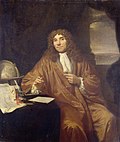| Leeuwenhoek Lecture and Medal | |
|---|---|
 The Leeuwenhoek Lecture and Medal is named in honour of the scientist Antonie van Leeuwenhoek (1632–1723) | |
| Awarded for | Recognising excellence in the field of microbiology, bacteriology, virology, mycology and parasitology, and microscopy |
| Location | London |
| Presented by | Royal Society |
| Reward(s) | £2000 and Medal |
| Website | royalsociety |
The Leeuwenhoek Lecture is a prize lecture of the Royal Society to recognize achievement in microbiology. [1] The prize was originally given in 1950 and awarded annually, but from 2006 to 2018 was given triennially. From 2018 it will be awarded biennially.
Contents
The prize is named after the Dutch microscopist Antonie van Leeuwenhoek and was instituted in 1948 from a bequest from George Gabb. A gift of £2000 is associated with the lecture. [1]
